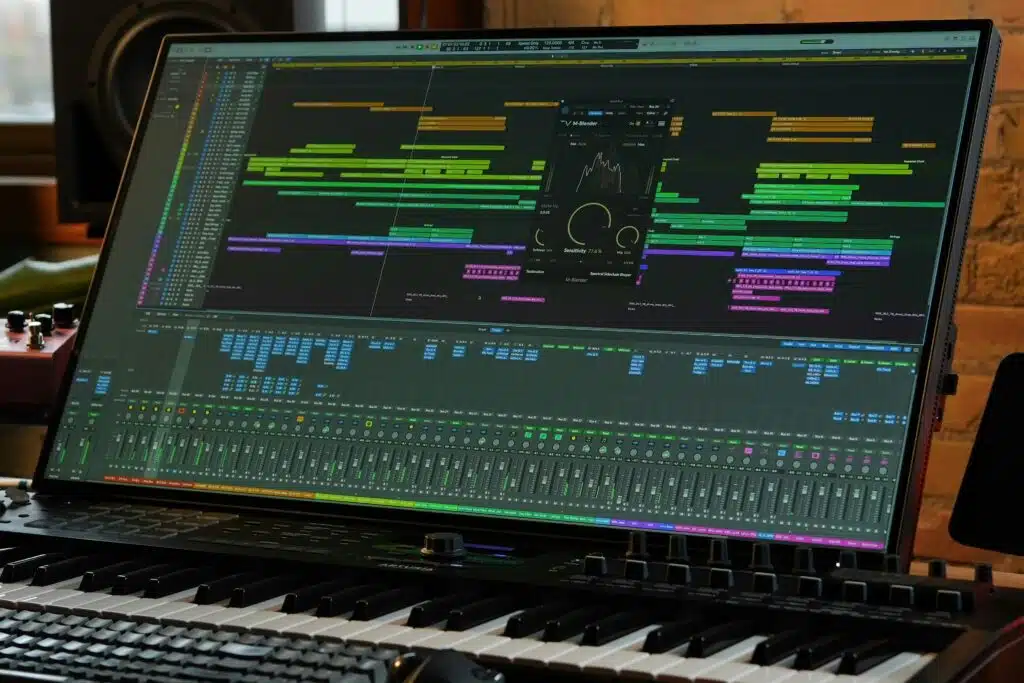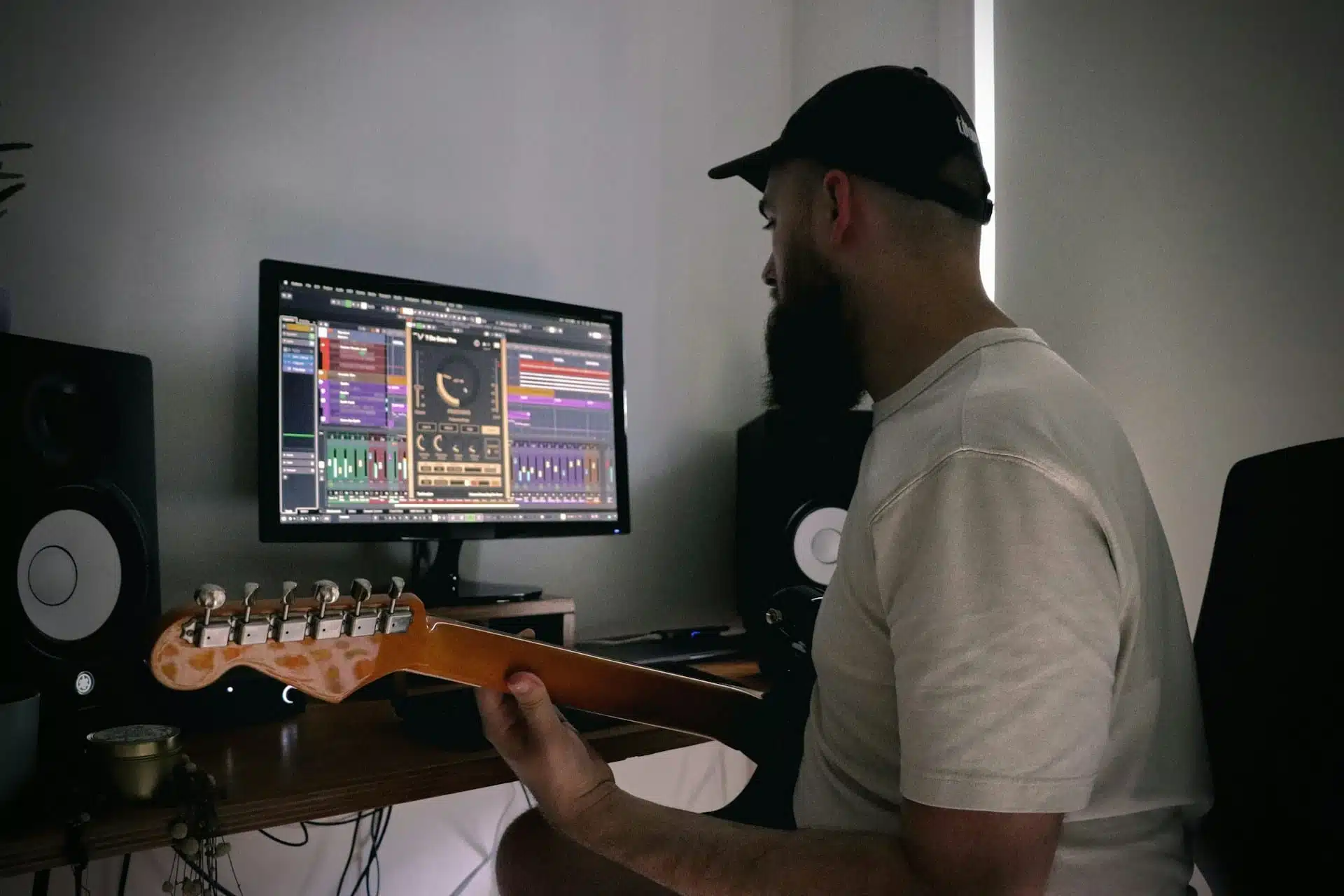Music plugins, including instruments and effects, can be a game changer for DIY musicians. A music plugin is a software application that emulates the sound of an analog instrument, digital audio processor, or another effect. Plugins are similar in effect to how a guitar pedal modifies a guitar’s tone. Some plugins offer functionalities like input gain adjustment and audio threshold manipulation. On the other hand, standalone effects can directly interface with your keyboard without the need for additional equipment.
Plugins are available in various formats, including VST, AU, AAX, among others. While their core principles are consistent, they differ in features and the interface platform they operate on.
Essentially, music plugins integrate with your music production software to manipulate and create sound. These plugins can enrich existing sounds, introduce new effects to an instrument’s signal, or even produce completely new sounds, known as ‘synthesized sounds’. Instruments within plugins function similarly to standard MIDI instruments, offering a broad spectrum of sonic possibilities.
How Plugins Work With A Digital Audio Workstation (DAW)
Plugins can be installed and used within any music software that supports them, but their primary function is to work within your DAW. Your DAW is the piece of software that you use to create and record music. It contains unique tracks or ‘busses’ that plugins can manipulate. By adding plugin effects to these busses, you can control how your digital audio sounds in terms of loudness, tone, and feel.
All DAWs will come with some built-in plugins (such as EQ). However, third-party manufacturers also produce plugins that are compatible with major DAWs like Ableton Live, FL Studio, Logic Pro X, and Pro Tools. These plugins usually come in the form of VSTs or Audio Units.
As well as using VST and Audio Units, there are other plugin standards that you might want to know about: LADSPA, LV2, DSSI, and AAX. The first three run natively on Linux platforms, whereas AAX is used only by the Pro Tools DAW.
What is a VST (Virtual Studio Technology)?
VST stands for Virtual Studio Technology. Steinberg created it as an open standard plugin platform that could substitute for the hardware synthesizers found in many studios. VSTs give DIY musicians access to more effects without breaking the bank.
Many professionals, including producers Simon Stockhausen and Jean-Michel Jarre, have used VSTs to make their music. It’s also easy for beginners to learn, with many plugins offering friendly interface designs.
Types of Virtual Instruments In VST Form
Many virtual instruments are available in VST form, such as drums and synthesizers. You can add sounds to your music with a drum machine virtual instrument or use loops from another source while recording on the fly. VSTs are helpful when you’re making music on stage and want to change up songs during a live set without having to stop and start. A virtual synthesizer can recreate an analog sound, with oscillators being the electronic components that create your tones.
Having so many options when creating music might seem confusing, but VSTs offer many benefits. If you’re making music with a group or just by yourself, they can provide you with an array of sounds to use in your songs. You can even record drum beats or loop instruments when you’re not using any musical tracks.
You can also create custom sounds and textures with digital synthesizers applied directly to analog sounds. This customization means that you can alter the sound of another instrument to make it something completely new.
When combined, VST plugins and instruments can provide an almost infinite number of possibilities for creating sounds. Also, you can open several plugins simultaneously and process the sound through various effects to create an entirely new instrument out of thin air. VSTs are compatible with any modern digital audio workstation (DAW) program typically used to record music.
Available VST Instruments
Instruments that are often found in VST format include:
- Guitar Plugins: Virtual guitar amplifiers and effects pedals for creating virtual guitars.
- Drums Plugins: Used to create custom drum samples, this type of vst plug-in is a one-stop-shop for building a complete kit.
- Synths: Synthesizer VSTs allow you to change the waveforms to your need and customize your sound.
- Instrument Racks: A rack of VSTs that create a complex instrument.
What is an AU?
Audio Units (AU) plugins are primarily used within macOS applications, including Logic and GarageBand. Unlike VST (Virtual Studio Technology) and AAX (Avid Audio eXtension) formats, which are cross-platform, AU plugins are designed specifically for the Apple ecosystem, taking advantage of the Core Audio framework to ensure seamless operation and integration with Apple’s operating systems.
AU plugins are renowned for their efficiency and low latency, making them a favorite among professionals for recording, mixing, and mastering. They can be categorized into various types:
- Instruments that generate sound.
- Effects that process audio.
- MIDI effects that manipulate MIDI data.
This flexibility allows users to significantly expand the capabilities of their audio software, enabling the creation of complex and high-quality audio productions.
Types Of AU Audio Plugins
Audio Units (AU) plugins can be broadly categorized into three main types, each serving distinct functions within the audio production and editing workflows. Understanding these categories helps users and developers utilize and create AU plugins effectively.
AU Instruments
AU Instruments, or AU synthesizers, are plugins designed to generate audio. They function as virtual instruments, emulating everything from classic synthesizers and pianos to other-worldly and novel sound sources. Users can play these instruments via MIDI controllers, sequencers, or recorded MIDI data within their DAW. These plugins offer endless creative possibilities for composing and arranging music across various genres.
AU Effects
AU Effects process audio signals to alter their sound. This category includes a wide range of effects, such as reverb, delay, compression, EQ, distortion, and more. AU Effects can be applied to individual tracks, buses, or the master output in a DAW, allowing producers and engineers to sculpt and enhance their audio. In summary, whether it’s subtle adjustment to fit a mix or drastic alteration for creative effect, AU Effects are tools for innovation and refinement in audio production.
AU MIDI Effects
AU MIDI Effects manipulate MIDI data rather than audio signals. These plugins can transform MIDI input in various ways, such as changing notes, velocities, rhythms, and more. MIDI Effects enable creative sequencing and pattern generation, offering a layer of creativity that can inspire new musical ideas or refine existing compositions. Also, they are particularly useful for dynamic performance modulation and automating complex MIDI operations in a project.
Together, these types of AU plugins form a comprehensive toolkit for audio production, enabling users to create, process, and modify both sound and music in powerful and creative ways. The diversity of AU plugins enriches the music production landscape on macOS and iOS, providing a wide range of sonic possibilities to explore.
Types of Effects In AU Plugin Format
There are dozens of effect types available as AU plugins. Here are a few of the most useful:
- Delay Plugins: Delays are pretty standard in the music production world. They can help give your song depth or create rhythmic effects.
- Distortion Plugins: Distortion is a go-to effect for many producers, capable of altering and shaping sounds to give your track a distinctive edge. This type of plugin can drastically transform your audio.
- Filter Plugins: Filters act similarly to EQs, allowing you to manipulate the highs and lows of any sound. They excel in crafting new textures for individual instruments or the entire mix, offering a dynamic way to shape your sound.
- EQ Plugins: Equalizers are fundamental in achieving a balanced mix, allowing you to adjust the low, mid, and high frequencies. They are crucial for crafting professional mixes by ensuring every element sits perfectly in the sonic spectrum.
- Reverb Plugins: Reverbs are essential for adding spatial depth to your mix, making sounds appear more three-dimensional and polished. By simulating different acoustic environments, they can dramatically enhance the atmosphere of your tracks.
- Vocal Processing Plugins: These plugins are designed to elevate vocal tracks, offering enhancements and clarity. Whether you’re crafting custom presets or using predefined settings, they can significantly improve the presence and impact of vocals in your mix.
- Compression Plugins: Compressors are invaluable for balancing the dynamic range across your mix, making loud parts softer and quiet parts louder. They are key to achieving a cohesive and level sound that stands out.
- Mastering Plugins: Mastering plugins are the powerhouses of post-production, refining your mix to professional standards. They eliminate unwanted noises and fine-tune your tracks with effects like reverb, ensuring your music is ready for release.
AAX Plugins Overview
An AAX (Avid Audio eXtension) plugin is a specific format developed by Avid Technology for use primarily with Pro Tools. AAX plugins were created to address the needs of Pro Tools users who wanted functionality beyond what AU plugins offer. So, they are designed to work seamlessly in both 32-bit and 64-bit environments. This means users can access high-quality 64-bit effects without the need for separate purchases.
Unique to AAX is the exclusivity of certain plugins to this format. This was a deliberate choice by Avid to ensure optimal performance and integration within Pro Tools. However, this exclusivity means that utilizing a broad range of effects simultaneously might be challenging without Pro Tools, a factor to consider before investing in AAX plugins.
Types of AAX Plugins
AAX plugins can be categorized into three main types, each serving a different function within the audio production workflow:
- Effects-Only Plugins: These are akin to standard Pro Tools plugins, allowing the addition of single effects directly to a channel strip. They enhance the audio processing capabilities without overwhelming the mix.
- Effects Plus All-in-One Plugins: Beyond offering singular effects, these plugins also include instruments, though they do not operate as separate tracks within the mixer window. This integration facilitates a more streamlined workflow, allowing for the simultaneous use of effects and instruments.
- Third-Party Bundles: These bundles are comprehensive packages from third-party developers that include multiple instruments and effects. They offer a wide range of sound manipulation and creative possibilities, making them a versatile choice for producers and engineers.
Top AAX Plugins On The Market
A few of the most popular AAX plugins are:
- The Sauce Bundle: This all-in-one third-party bundle is packed with effects and a variety of virtual instruments. It’s designed to provide a comprehensive set of tools for creating backing tracks or layering sounds directly within the project view.
- Reason 11.1: This is specifically tailored for use within Propellerhead Software’s Reason. The plugin extends its functionality by including third-party effects accessible both in the mixer window and project view. Reason 11.1 enriches the sound design and production capabilities.
- Universal Audio UAD Plugins: Compatible with the Universal Audio Apollo series, these plugins offer a range of effects and instruments that enhance productions when used with an Apollo interface, integrating smoothly into your DAW for a seamless workflow.
- Waves Plugins: Known for their wide DAW compatibility, Waves plugins are designed for use with Waves’ hardware interfaces but also work well with third-party software. They offer a broad spectrum of audio processing tools, from effects to virtual instruments, catering to various production needs.
Final Thoughts On Plugins For Music Producers
These music plugin file formats are available for both Mac and Windows systems with appropriate hosts. Google is the best way to find out where you’re able to access each type of file.
Music plugin files make digital audio processing possible for anyone who uses them. If you want to try out new effects without buying expensive hardware, plugins are the way to go! Simply find a free download or purchase plugin bundles from your favorite software host and you can try these tools today.
Furthermore, plugins are important tools in mixing and mastering so it is important to understand their uses. Bay Eight Recording Studios offers professional recording and music production services with state-of-the-art equipment, and we’d love to hear from you if you need help producing your next track!












